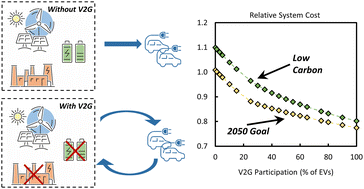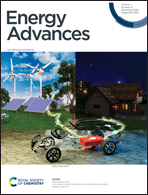Can vehicle-to-grid facilitate the transition to low carbon energy systems?†
Abstract
Vehicle-to-grid (V2G) is when electric vehicles (EVs) provide services to the power grid, such as shifting when they charge or discharging to serve peaks loads. At scale, an aggregator can coordinate and optimize the charge and discharge of individual vehicles to function as a synergistic, bulk energy resource and load. Here we generate new insights into V2G's long run value for deep decarbonization, assessing its potential to displace stationary storage and other generators at scale. As a case study, V2G impact is measured via the buildout and operation of a New England-sized power system subject to high EV penetration and tight emissions constraints. We find V2G's effect on system capacity and value to be substantial, with participation from 13.9% of the New England light-duty vehicle fleet displacing 14.7 GW of stationary storage (over $700 million in capital savings). On the whole, total system savings span 2.2% to 20.3% ($183–1326 million) between participation rates of 5% and 80%, respectively. Savings are driven first by displacement of stationary storage, and second by reductions in firm generation capacity and shifts in renewable generation portfolios. When compared to traditional demand response schemes, even at modest participation rates (5–10%), V2G yields over 337% more savings and tenfold the storage displacement. V2G's marginal benefit is greatest under aggressive emission caps (10 gCO2 per kW per h per load), as it decreases the need for excess renewables capacity and costly CCS technologies. Further, the nature of optimal V2G dispatch is shown to change non-monotonically with participation rate. Below 50% participation, V2G power injection is called on at a higher rate to shave evening charging loads, with 21.3–32.8% of charge reinjected to the grid, whereas greater participation rates require significantly less reinjection (<15%) via charge load shifting. Finally, our destination-based system topology quantifies locational V2G contributions and reveals that V2G capabilities are as much as 2.5 times more valued in residential areas than at workplaces alone.

- This article is part of the themed collections: Energy Advances: Highlight USA & Canada and Electric vehicles and batteries


 Please wait while we load your content...
Please wait while we load your content...